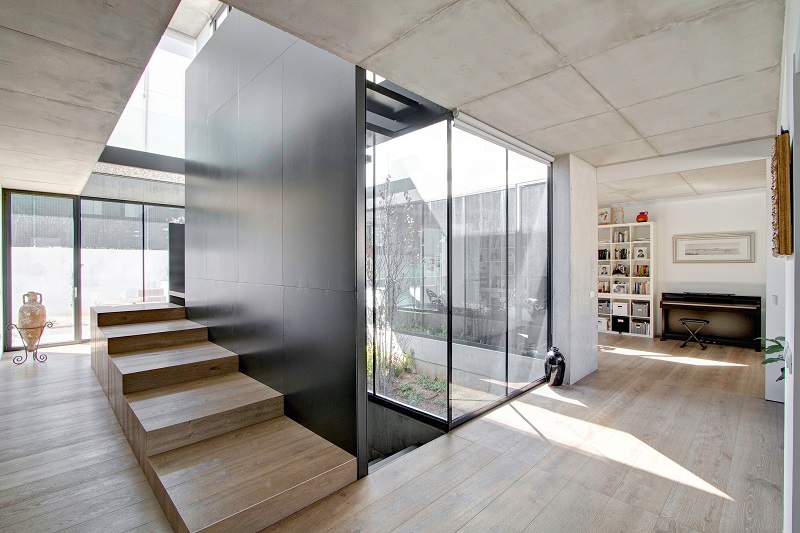Torben Hansen of Schotten & Hansen about his humble beginnings and a journey that has led his company to the top league of international craftsmanship.

01. When did your love of timber begin and how did this lead to the establishment of a globally renowned supplier of high-quality timber flooring and interior solutions?
As a child, I earned money for the first time by burning furniture. I grew up in Denmark, where shelf warmers were used for heating in my father’s auction house. I collected chairs, tables, cabinets and the like, many of which were of good quality. It hurt me to destroy these beautiful objects but it definitely shaped my character and enabled me to recognise good quality when I see it. I also learned to value products as they grow old and to create them as well. That was and still is my inspiration.
02. As a craftsman, when you began your career working with timber were you focused on the realities of business or was it more of an emotional response to working with a natural product that attracted you to your profession?
My passion for handicraft has always stood in the foreground. I always sought to delve deeper into the material, to understand it, and to become better in my work. I was inspired to make products that would be valued emotionally and the business was a natural progression.
03. After a lifetime handcrafting timber into prestige interior solutions is there still more to learn about the timbers you work with?
Over the years we have reached a very high level of craftsmanship and have developed methods that fundamentally differ from the rest of the industry. Despite our deep understanding of how wood works there is always something new to discover. The complexity of nature is fascinating and I still learn something new every day. We have a deep respect for this natural wonder, which we always seek to convey to our customers and partners.

04. Is there one thing you now know about working with timber that you wish you had known when you started your career? What is this?
I would probably start the same way again, knowing nothing. What really drives me is research – I want to discover the secrets myself and solve problems. I realized early on – that even the old masters did not know everything. Even today, many work steps are still “made this way, because that’s how it has always been done”! I questioned this approach, looked for my own answers and think this is the only way to really innovate.
05. When you started Schotten & Hansen were you focused on supplying your local building industry or were you always focused on having an international presence?
The two of us started restoring old furniture in a barn. At first in a small alpine village, selling locally, then more and more nationwide. Internationalization began in the late 1990s when international carpenters and salespeople discovered our products and recognized their uniqueness at trade fairs or via word of mouth.

06. How did you transition from a small regional business into a globally known brand? Was there a moment when things changed quickly or has this been a gradual evolution over time?
After the first international contacts, my brother started selling our products in London. More or less at the same time we started selling in the USA, then in Spain. This resulted in new contacts being developed in other countries and today we have delivered our products and expertise to clients in more than one hundred countries.
07. Is it easy to find workers from the younger generation who share a passion for learning about and building careers working with timber?
The company is located on the edge of the Alps. The region is characterised by a centuries-old handicraft culture. The profession is still respected and there are always young trainees locally who want to come on board. We always try to encourage and develop the best talent, as this is the only way we can continue to grow our reputation internationally.
08. In an industry where great value is derived from the product being “hand-crafted”, how has the application of new technologies added value to the operation and product?
It is a matter of objective. We want to achieve maximum quality in refining and finishing wood to preserve its authentic characteristics. At the same time we want to meet the most complex requirements of architecture and design. Therefore, we always use the best available tools or simply come up with our own solution. Over the years we have developed our own ways of finishing, deliberately refraining from any chemical modification and using only organic ingredients. We combine our knowledge of old methods of furniture restoration with techniques based on modern research. Our use of CNC milling and laser scanners for example only complements what we do by hand using old handicraft techniques.

09. Your name is now synonymous with luxury yachts. How did your relationship with some of the most prestigious boat designers begin and how important is this sector to Schotten & Hansen’s business moving forward?
Our first yacht was a great step forward in the development of our business. Following a joint project with a British designer, this customer offered our products to another customer for their boat. The shipyard was initially sceptical and while the demands for quality, precision and materials presented us with great challenges we rose to that challenge and learned a great deal that helped us expand in all areas. Today, we can claim to be among the best, not only in terms of product quality and the flexibility of our portfolio, but also in terms of consulting and planning services.
10. What is the best thing about being the CEO of Schotten & Hansen?
Always being able to continue learning, always meeting new challenges! It is my life’s work.
11. Is there anything specific that you would like to share with the readers of PRC Magazine?
The importance and understanding of quality and value is more important to me than anything else. In today fast moving world, there will always be a tendency for people to create something that is cheap and simple and in this scenario the desire for quality material and craftsmanship often gets thrown to the wayside. I believe the world would be a better place if was less seduced by the bottom line, and were more inspired by the natural and authentic.













